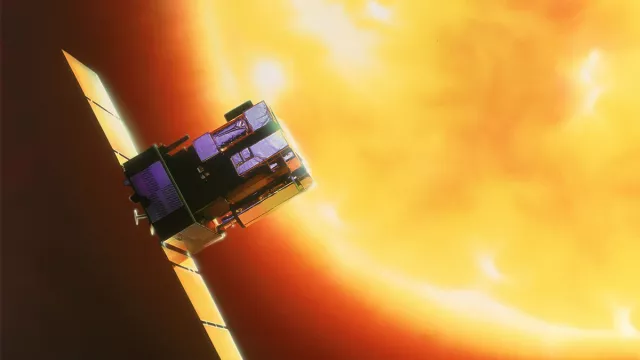The SOHO satellite is one of the European Space Agency’s most ambitious projects from the 1990s. Launched in 1995, it is still operating with its instruments pointed permanently at the Sun.
Key information
Key figures
- 1,850 kg: satellite mass
- 4.3 m x 2.7 m x 3.7 m: satellite dimensions
- 12 instruments
- 5 contributing French laboratories
Key milestones
- 31 December 2025: End of mission
- 1997 to 2024: Mission extended multiple times by ESA
- 2 December 1995: SOHO launched by Atlas II
- 1984: ESA selects SOHO project for its Horizon 2000 programme
Project in brief
The SOHO satellite (SOlar Heliospheric Observatory) was designed to study the Sun’s interior structure (helioseismology), its outer atmosphere (heliosphere) and the origin of the solar wind. Its observations have helped scientists to better understand the interactions between the Sun and Earth’s environment and to gain new insights into some of our star’s best-kept secrets, such as how its corona is heated. SOHO has an uninterrupted view from its vantage point in a halo orbit around the L1 Lagrange point 1.5 million kilometres from Earth in the direction of the Sun.
The first cornerstone, along with the Cluster mission, of the European Space Agency’s Horizon 2000 programme, SOHO has revealed the Sun’s dynamic variations over a range of timescales and in this respect it can be considered the forerunner of the new field of science known as space weather and meteorology.
France helped to fund SOHO through its contribution to ESA’s mandatory science programme and built three of the satellite’s 12 instruments. It also worked on the design of three other instruments and is playing a key role in exploiting the mission’s science data through the MEDOC data centre at the IAS space astrophysics institute in Orsay.
The SOHO-LASCO coronagraph is currently the only space instrument delivering regular images—100 or so a day—of the Sun’s corona, which are used especially in space weather forecasting.
CNES’s role
CNES helped to fund SOHO through its contribution to ESA’s mandatory science programme and directly through the national programme for its involvement with the spacecraft’s instruments and through the MEDOC data centre.
For MEDOC, IAS is project leader with responsibility for interfacing with PIs, the SOHO Experimenters' Operations Facility (EOF), ESA and the SOHO Working Team (made up of PIs). CNES is in charge of communications between the Orsay facility and the EOF, and long-term data archiving. In operations mode, IAS works with the PIs and Co-Is involved with SOHO’s instruments.
Contacts
Sun, Heliosphere & Magnetospheres subject matter expert
Kader Amsif
E-mail: kader.amsif at cnes.fr


